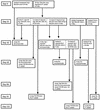Characterization of transmission of Pneumocystis carinii f. sp. muris through immunocompetent BALB/c mice
- PMID: 12819069
- PMCID: PMC161994
- DOI: 10.1128/IAI.71.7.3852-3856.2003
Characterization of transmission of Pneumocystis carinii f. sp. muris through immunocompetent BALB/c mice
Abstract
By using mouse models, it has been shown that Pneumocystis carinii f. sp. muris can be transmitted to immunocompetent mice that are exposed to immunosuppressed mice with active P. carinii pneumonia. We sought to determine whether P. carinii f. sp. muris could be transmitted between normal mice. The rationale for these experiments was to demonstrate whether the normal host could serve as the reservoir of organisms that produce Pcp when the organism is acquired by the immunosuppressed host. Under the conditions of these experiments, normal mice are able to be infected by brief cohousing with P. carinii-infected SCID mice. There was active replication of organisms in the normal host such that the organism could be transmitted to other normal mice, again with active replication. Mice that had seroconverted after exposure to P. carinii-infected SCID mice were more resistant to infection when reexposed. Infection in normal mice was well tolerated with minimal effects on dynamic lung compliance. We speculate, based on these results, that transmission from normal host to normal host, as an asymptomatic or minimally symptomatic infection, could be a way to maintain this opportunistic pathogen in the environment.
Figures
Similar articles
-
Exposure of immunocompetent adult mice to Pneumocystis carinii f. sp. muris by cohousing: growth of P. carinii f. sp. muris and host immune response.Infect Immun. 2003 Apr;71(4):2065-70. doi: 10.1128/IAI.71.4.2065-2070.2003. Infect Immun. 2003. PMID: 12654827 Free PMC article.
-
Transmission of Pneumocystis carinii disease from immunocompetent contacts of infected hosts to susceptible hosts.Eur J Clin Microbiol Infect Dis. 2000 Sep;19(9):671-8. doi: 10.1007/s100960000354. Eur J Clin Microbiol Infect Dis. 2000. PMID: 11057500
-
Immunocompetent hosts as a reservoir of pneumocystis organisms: histological and rt-PCR data demonstrate active replication.Eur J Clin Microbiol Infect Dis. 2004 Feb;23(2):89-97. doi: 10.1007/s10096-003-1092-2. Epub 2004 Jan 8. Eur J Clin Microbiol Infect Dis. 2004. PMID: 14712369
-
[Pneumocystis carinii is still a dangerous opportunist. The infection is continuously a threat to immunocompromised patients].Lakartidningen. 1999 Jan 27;96(4):328-31. Lakartidningen. 1999. PMID: 10024821 Review. Swedish.
-
Genetics, metabolism and host specificity of Pneumocystis carinii.Med Mycol. 1998;36 Suppl 1:183-93. Med Mycol. 1998. PMID: 9988507 Review.
Cited by
-
Colonization by Pneumocystis jirovecii and its role in disease.Clin Microbiol Rev. 2012 Apr;25(2):297-317. doi: 10.1128/CMR.00013-12. Clin Microbiol Rev. 2012. PMID: 22491773 Free PMC article. Review.
-
Exogenous heat-killed Escherichia coli improves alveolar macrophage activity and reduces Pneumocystis carinii lung burden in infant mice.Infect Immun. 2007 Jul;75(7):3382-93. doi: 10.1128/IAI.00174-07. Epub 2007 May 7. Infect Immun. 2007. PMID: 17485459 Free PMC article.
-
Humans Are Selectively Exposed to Pneumocystis jirovecii.mBio. 2020 Mar 10;11(2):e03138-19. doi: 10.1128/mBio.03138-19. mBio. 2020. PMID: 32156824 Free PMC article.
-
Pneumocystis murina colonization in immunocompetent surfactant protein A deficient mice following environmental exposure.Respir Res. 2009 Feb 19;10(1):10. doi: 10.1186/1465-9921-10-10. Respir Res. 2009. PMID: 19228388 Free PMC article.
-
Guidelines for the prevention and treatment of opportunistic infections in HIV-exposed and HIV-infected children: recommendations from the National Institutes of Health, Centers for Disease Control and Prevention, the HIV Medicine Association of the Infectious Diseases Society of America, the Pediatric Infectious Diseases Society, and the American Academy of Pediatrics.Pediatr Infect Dis J. 2013 Nov;32 Suppl 2(0 2):i-KK4. doi: 10.1097/01.inf.0000437856.09540.11. Pediatr Infect Dis J. 2013. PMID: 24569199 Free PMC article. No abstract available.
References
-
- Centers for Disease Control. 1986. Update: acquired immunodeficiency syndrome: United States. Morb. Mortal. Wkly. Rep. 35:757-766. - PubMed
-
- Dumoulin, A., E. Mazars, N. Seguy, D. Gargallo-Viola, S. Vargas, J. Cailliez, E. M. Aliouat, A. E. Wakefield, and E. Dei-Cas. 2000. Transmission of Pneumocystis carinii disease from immunocompetent contacts of infected hosts to susceptible hosts. Eur. J. Clin. Microbiol. Infect. Dis. 19:671-678. - PubMed
Publication types
MeSH terms
Grants and funding
LinkOut - more resources
Full Text Sources
Other Literature Sources


